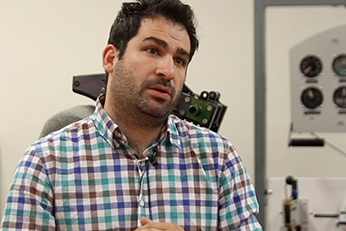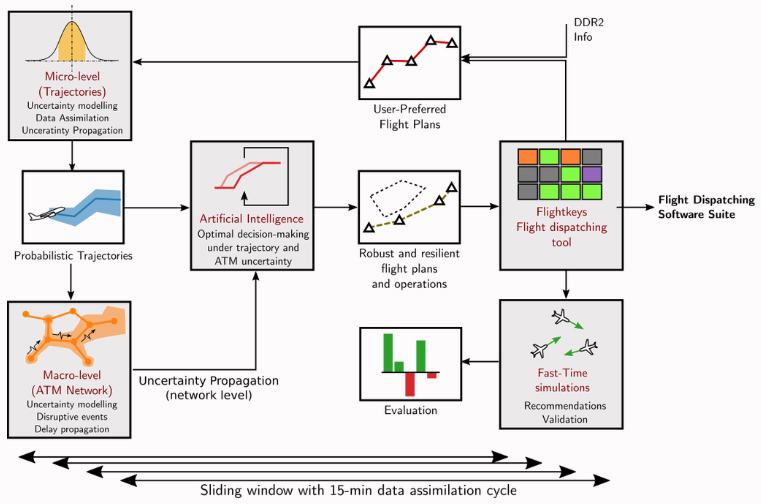
Like cars on the road, aircraft in the sky sometimes have to adapt their intended plan due to unforeseen events, such as last-minute changes in take-off times, bad weather conditions or traffic disruptions. Finding ways to reduce these uncertainties and design trajectories that are more robust is the goal of START, a recently launched SESAR exploratory research project within the framework of Horizon 2020. In this interview, Manuel Soler, START coordinator from the Universidad Carlos III de Madrid, explains why addressing these uncertainties is so critical to building more resilient air traffic management.
What is trajectory-based operations and why is it so important for air travel?
In the future European air traffic management (ATM) system, the trajectory becomes the fundamental element of a new set of operating procedures, collectively referred to as trajectory-based operations (TBOs). With TBO, aircraft can fly their preferred flight trajectories (business trajectory), delivering passengers on time to their destination as cost effectively and sustainably as possible. A key enabler for TBO is the automated updating of trajectories in response to uncertainties as they arise. However, a high frequency of updates and modifications can result in destabilising the performance of system and the overall network.
What is START aiming to achieve?
The overall goal of START (a Stable and resilienT ATM by integrAting Robust airline operations into the neTwork) is to develop and validate optimisation algorithms to make trajectories more predictable and ensure more stable and resilient ATM performance even in disturbed scenarios. In this context, resilience refers to the intrinsic ability of a system to adjust its functioning prior to, during, or following changes and disturbances, so that it can sustain required operations under both expected and unexpected conditions, as defined by Eurocontrol in its white paper on resilience engineering for ATM. Resilience implicitly refers to the behaviour of the system against disturbances over a considered time horizon; therefore, it requires continuous data assimilation. In other words, a system is resilient when it can adapt to internal and external challenges over a time interval by changing its method of operations while continuing to function. While elements of the original system are present, there is a fundamental shift in core activities in response to the new environment.
What are the kind of uncertainties make predicting trajectories difficult?
There are two main kinds of uncertainties, which the project is focusing on:
- Uncertainties at the micro-level or trajectory level, associated with wind forecasts, aircraft performance models, aircraft weight estimations, aircraft intent and take-off times.
- Uncertainties at the macro-level or ATM network level, e.g, due to disruptive events in the network such as thunderstorms, including the propagation of micro-level (trajectory level) delays over origin-destination pairs.
Is it possible to eliminate uncertainty in trajectory prediction?
No, it is not possible to eliminate it: uncertainty is inherent in complex systems such as the ATM system. Because the system exhibits a collective behaviour, it cannot be modelled by simply looking at the micro-level elements of the systems, i.e., trajectories. We first need to understand the uncertainties and, where possible, reduce them. But ultimately, we need to manage them because they will not disappear.
Is this the first time that this challenge is being addressed or is the project building on previous research?
START leverages trajectory and weather uncertainty modelling capabilities developed in previous SESAR projects, such as COPTRA and TBO-Met, and it also addresses two of the challenges set by Engage, on data-driven trajectory prediction, and the efficient provision and use of meteorological information in ATM.
You are using artificial intelligence in your research - What are the benefits of using AI applications?
Yes, we are using AI in several ways. For instance, we will use data (observation of certain phenomena) to assimilate probability distribution functions every 15 minutes. We will also be using an epidemiological metaheuristic or procedure to mimic the aerial transportation network and build a delay propagation model between nodes (airports, waypoints, sectors) of the network. To maximise network resilience, while preserving the business preferences of the airlines as much as possible, we will rely on simulated annealing metaheuristics, an algorithm that mimics the annealing or heat treatment process in metallurgy.
Who will benefit from the results of your research? Which stakeholders are concerned?
More robustly-calculated trajectories will benefit airlines, since they will help reduce the number of tactical interventions needed by air traffic control, the ground/aerial holdings, all in all reducing deviations from airlines’ business preferences. We also believe that it can also help reduce the number of regulations issued and disruptions to the overall Network.
.

START has received funding from the SESAR Joint Undertaking under the European Union's Horizon 2020 research and innovation programme under grant agreement No 893204.
